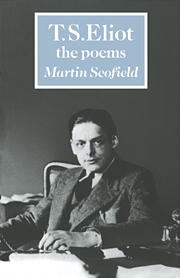Book contents
- Frontmatter
- Contents
- Acknowlegements
- Chronology
- Introduction
- 1 Aspects of the life of the poet
- 2 Early poetic influences and criticism, and Poems Written in Early Youth
- 3 Prufrock and Other Observations (1917)
- 4 Poetic theory and poetic practice
- 5 Poems (1920)
- 6 The Waste Land (1922)
- 7 From The Hollow Men (1925) to ‘Marina’ (1930)
- 8 Poetry, pattern and belief
- 9 From Coriolan (1931) to ‘Burnt Norton’ (1936)
- 10 ‘Burnt Norton’ (1936) and the pattern for Four Quartets
- 11 The wartime Quartets (1940–2)
- Notes
- Select bibliography
- Index
8 - Poetry, pattern and belief
Published online by Cambridge University Press: 18 January 2010
- Frontmatter
- Contents
- Acknowlegements
- Chronology
- Introduction
- 1 Aspects of the life of the poet
- 2 Early poetic influences and criticism, and Poems Written in Early Youth
- 3 Prufrock and Other Observations (1917)
- 4 Poetic theory and poetic practice
- 5 Poems (1920)
- 6 The Waste Land (1922)
- 7 From The Hollow Men (1925) to ‘Marina’ (1930)
- 8 Poetry, pattern and belief
- 9 From Coriolan (1931) to ‘Burnt Norton’ (1936)
- 10 ‘Burnt Norton’ (1936) and the pattern for Four Quartets
- 11 The wartime Quartets (1940–2)
- Notes
- Select bibliography
- Index
Summary
Between the publication of The Hollow Men (1925) and that of ‘Burnt Norton’ (1936) Eliot's thinking about poetry, as well as his own poetic style, underwent some radical changes and developments; and the changes in the style are so closely linked to the critical thinking that it is illuminating to consider these changes and developments in the criticism in relation to the poems. We can identify three main areas of critical thinking which are particularly relevant to the poetry after 1925: the consideration of the qualities of good verse, with a particular consideration of the virtues of prose qualities in verse on one hand, and on the other those qualities of music and symbolism which take verse to an opposite extreme from prose; the interest in the pattern made by a poet's work as a whole (where the main examples are Shakespeare and Dante); and finally the question of the relation of poetry to philosophy and belief.
Of Eliot's poetry and poetic criticism up until 1922 and the publication of The Waste Land, it is fair to say that there is a widespread emphasis on values derived from Donne and the Metaphysical poets, together with those of certain French poets, in particular Laforgue. What these groups had in common (for all their differences) was a striking heterogeneity of imagery, and a tendency to ‘difficulty’, a need ‘to force’ – in Eliot's words, ‘to dislocate if necessary’ – language to their meaning.
- Type
- Chapter
- Information
- T. S. Eliot: The Poems , pp. 167 - 182Publisher: Cambridge University PressPrint publication year: 1988



